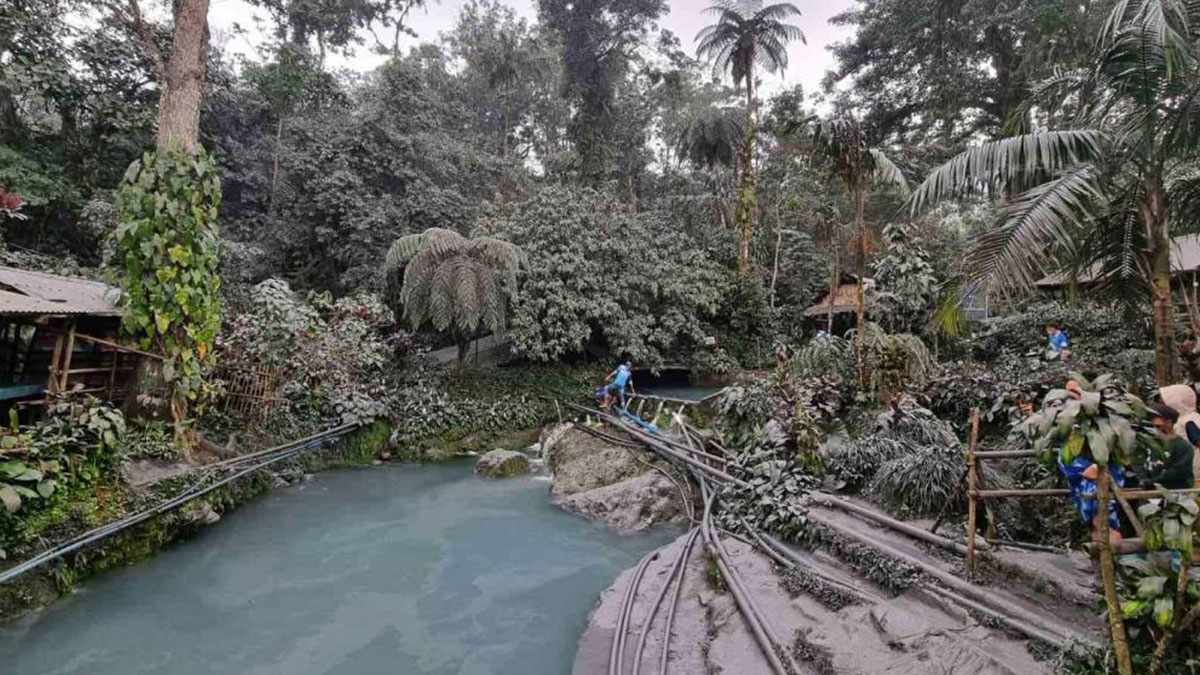

NO WINTER WONDERLAND Ashfall from the eruption of Mt. Kanlaon on Monday has blanketed much of Negros Occidental province, like here at Guintubdan Spring in Barangay Araal, La Carlota City. Photo taken on Dec. 10. —LA CARLOTA CITY WATER DISTRICT PHOTO
Local sugar production may decline further if Mt. Kanlaon’s eruption dumps more ash onto sugar plantations in the Philippines, according to the Sugar Regulatory Administration (SRA).
SRA administrator Pablo Luis Azcona said in an informal gathering on Tuesday that ashfall from Mt. Kanlaon would have “a burning effect” on sugarcane, resulting in a diminished harvest.
Article continues after this advertisement“The main problem, according to technicians and scientists, is the acidity of ash,” Azcona told reporters.
FEATURED STORIES BUSINESS BIZ BUZZ: Naia to bid turboprops adieu BUSINESS Why enjoying life now is better than delaying until retirement BUSINESS Pogo phaseout in full swing; only 17 remainREAD: Mt. Kanlaon calms down
He said that if the ash stays longer on sugarcane leaves, plants could die as this harmful compound could burn them and cause early maturation.
Article continues after this advertisement“The sugar [in the sugarcane] will turn into vinegar, more or less, so the plant will die,” Azcona added.
Article continues after this advertisementAlthough the impact of the eruption last June was minimal, Azcona said the latest reports indicated that La Carlota, one of the largest sugarcane areas in the country, was affected by the volcanic eruption.
Article continues after this advertisementHe said that La Carlota is home to one of the biggest single mills in Negros, while the Association of Farmers of Carlota and Pontevedra Inc. is among the biggest sugar groups nationwide, accounting for 10 percent of the entire sugar production.
Azcona also said Bago City has areas for sugarcane cultivation, although rice is the primary commodity cultivated in the area.
Article continues after this advertisementCiting the monitoring of the local governments in Western Visayas, the SRA said other affected areas in Negros Occidental include La Castella, Pontevedra, San Enrique, Hinigaran, Valladolid, and Pulupandan.
Azcona said that if standing crops get affected, the country’s buffer stock of sugar would take a hit.
Mt. Kanlaon erupted anew on Monday, spewing heavy ashfall and emitting strong sulfuric fumes. The last eruption was recorded on June 3, damaging P84.1 million in crops and fisheries.
Even before the eruption, the SRA had estimated that local output would decline to 1.78 million metric tons (MT) for crop year September 2024 to August 2025 from the 1.922 million MT of sugar produced from 2023 to 2024.
Subscribe to our daily newsletter
The agency attributed the lower projection to “the anticipated negative effect of the prolonged El Niño phenomenon unless the La Niña phenomenon brings about an increase in production.” INQpampawerte
READ NEXT DTI gives shopping tips for the holiday season RCBC’s tech visionary earns spot on esteemed CIO 100 ASEAN list EDITORS' PICK World Bank trims PH growth outlook Wet, cloudy Wednesday in many parts of PH - Pagasa Biden says Trump economic plan will be 'disaster' Malibu fire destroys homes, forces evacuations and school closures LIVE: UAAP Season 87 basketball Finals Game 2 – La Salle vs UP Marcos vows to make overseas work a choice, not a necessity MOST READ PH-US-Japan maritime talks flag ‘unlawful’ Chinese behavior in West PH Sea Grab told to explain why drivers shoulder 20-percent fare cut VP Duterte skips NBI probe, denies making threats in letter COA told: Release info on Office of the President’s secret funds Follow @FMangosingINQ on Twitter --> View commentsPowered by CODVIP|711BET Online Casino|711 bet login app|711 bet Slots Casino @2013-2022 RSS Map HTML Map